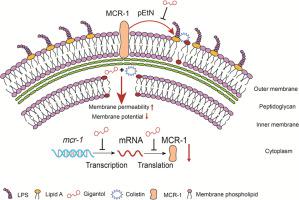Phytomedicine ( IF 7.9 ) Pub Date : 2023-05-22 , DOI: 10.1016/j.phymed.2023.154886 Yanhu Huang 1 , Zhiqiang Wang 2 , Ziyi Liu 1 , Quanmin Huan 1 , Yuan Liu 3 , Ruichao Li 3 , Mianzhi Wang 3 , Xia Xiao 3

|
Background
The emergence and wide spread of plasmid-mediated colistin resistance gene (mcr-1) and its mutants have immensely limited the efficacy of colistin in treating multidrug-resistant (MDR) Gram-negative bacterial infections. The development of synergistic combinations of antibiotics with a natural product that coped with the resistance of MDR bacteria was an economic strategy to restore antibiotics activity. Herein, we investigated gigantol, a bibenzyl phytocompound, for restoring in vitro and in vivo, the sensitivity of mcr-positive bacteria to colistin.
Methods
The synergistic activity of gigantol and colistin against multidrug-resistant Enterobacterales was studied via checkerboard assay and time-killing curve. Subsequently, the transcription and protein expression levels of mcr-1 gene were determined by RT-PCR and Western blots. The interaction of gigantol and MCR-1 was simulated via molecular docking and verified via site-directed mutagenesis of MCR-1. Hemolytic activity and cytotoxicity assay were used to evaluate the safety of gigantol. Finally, the in vivo synergistic effect was evaluated via two animal infection models.
Results
Gigantol restored the activity of colistin against mcr-positive bacteria E.coli B2 (MIC from 4 μg/ml to 0.25 μg/ml), Salmonella 15E343 (MIC from 8 μg/ml to 1 μg/ml), K. pneumoniae 19-2-1 (MIC from 32 μg/ml to 2 μg/ml) carrying mcr-1, mcr-3, mcr-8, respectively. Mechanistic studies revealed that gigantol down-regulated the expression of genes involved in LPS-modification, reduced the MCR-1 products and inhibited the activity of MCR-1 by binding to amino acid residues Tyr287 and Pro481 in its D-glucose-binding pocket. Safety evaluation showed that the addition of gigantol relieves the hemolysis caused by colistin. Compared with monotherapy, the combination of gigantol and colistin significantly improved the survival rate of Gallgallella mellonella larvae and mice infected by E.coli B2. Moreover, there was a considerable decrease in the bacterial load present in the viscera of mice.
Conclusion
Our results confirmed that gigantol was a potential colistin adjuvant, and could be used to tackle multi-drug resistant Gram-negative pathogen infections combined with colistin.
中文翻译:

Gigantol 可恢复携带多重耐药细菌的 mcr 对粘菌素的敏感性
背景
质粒介导的粘菌素抗性基因(mcr-1)及其突变体的出现和广泛传播极大地限制了粘菌素治疗多重耐药(MDR)革兰氏阴性细菌感染的功效。开发抗生素与天然产物的协同组合来应对耐多药细菌的耐药性是恢复抗生素活性的经济策略。在此,我们研究了 gigantol(一种联苯甲基植物化合物),用于在体外和体内恢复mcr阳性细菌对粘菌素的敏感性。
方法
通过棋盘试验和时间杀伤曲线研究了吉甘多醇和粘菌素对多重耐药肠杆菌的协同活性。随后,通过RT-PCR和Western blotting测定mcr -1基因的转录和蛋白表达水平。gigantol 和 MCR-1 的相互作用通过分子对接进行模拟,并通过MCR-1 的定点诱变进行验证。采用溶血活性和细胞毒性测定来评价gigantol的安全性。最后,通过两种动物感染模型评估体内协同效应。
结果
Gigantol 恢复了粘菌素对mcr阳性细菌大肠杆菌B2(MIC 从 4 μg/ml 至 0.25 μg/ml)、沙门氏菌15E343(MIC 从 8 μg/ml 至 1 μg/ml)、肺炎克雷伯菌19-的活性2-1(MIC从32μg/ml至2μg/ml)携带mcr -1、mcr -3、mcr分别为-8。机制研究表明,gigantol 下调参与 LPS 修饰的基因表达,减少 MCR-1 产物,并通过与 D-葡萄糖结合口袋中的氨基酸残基 Tyr287 和 Pro481 结合来抑制 MCR-1 的活性。安全性评价表明,gigantol的添加缓解了粘菌素引起的溶血。与单药治疗相比,gigantol和粘菌素联合使用显着提高了大蜡螟幼虫和大肠杆菌B2感染小鼠的存活率。此外,小鼠内脏中的细菌负荷显着减少。
结论
我们的结果证实,gigantol是一种潜在的粘菌素佐剂,可与粘菌素联合用于治疗多重耐药革兰氏阴性病原体感染。



























 京公网安备 11010802027423号
京公网安备 11010802027423号